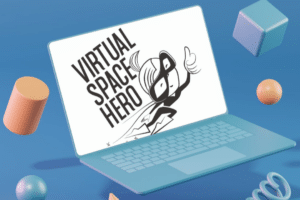Written by

BarbaraCV
#virtualspacehero
As learning professionals, we often fall into the trap of “getting through all our program content”. The focus tends to be less on creating learner-driven environments and more on just delivering content. Often, we’ve heard from learning professionals that you’re unsure after a session about how much of the learning will be retained and more importantly used by your learners. It’s about finding that balance between letting your learners create and discover knowledge, and your inputs as subject matter experts – that is not always an easy balance to find. And now, in the virtual space, online learning journeys are an even bigger challenge.
If training is evaluated, the poor conclusion is often that we might see quite good results at the Reaction Level of Kirkpatrick’s Training Evaluation Model. However, declines of 20% to 50% are recorded between the effectiveness of training at Level 1 (Reaction) and Level 3 (Behavior) (Rehmat et al 2015).
We can do better!
And we believe that the virtual space provides us with the possibility to design for “real” learning journeys more easily.
This blog article summarises the main points from a LinkedIn Live with Melanie Martinelli (Co-Founder & Director The Learning Gym Ltd.) and Barbara Covarrubias Venegas (Founder #virtualspacehero) about how we can use the virtual space to bring online learning journeys alive. Melanie designed together with her Co-Founder Shilpa Subramaniam 8 Fitness Tracks. All focusing on upskilling learning professionals to deliver powerful virtual training.
WHY and HOW does the Virtual Space Bring Online Learning Journeys Alive?
One big argument of virtual training is the economic aspect of delivery. It would never be possible for a trainer and all participants to be brought back every 1 or 2 weeks to attend a workshop session. The virtual space makes this and other aspects of the online learning journeys much easier for both the trainer and the learners.
✨Space the learning
As learning designers we can design online courses differently. We can plan more time in between sessions to support our participants in the application of the learnings. This allows to have more opportunities to practice and to reflect on the skills they have learned. You can for example split the classical 8-hour training into a spaced format. Could be 4+4 hour (most common) or 3+4+2 hours workshops. Then redesign the content to make it happen in 2-3 weeks’ time. This way, you can plan a peer activity, a coaching activity, and even some reading material to be done between the sessions. Therefore help your participants to have a deeper learning experience.
“I really like virtual space because it gives me the opportunity to design and execute learning journeys the way I always wanted to do.” Melanie Martinelli
✨ Time to Practice
What helps people to apply the learnings, is to have the opportunity to practice, reflect on the experience, and go back to ask their questions. In the virtual space, you can share the content in an asynchronous mode of learning, before or after the session. This way people can consume and go through it at their own speed. Able to come to the next live session ready with questions, and really have the opportunity to practice and dive deep into the topic.
Consider tools such as Padlet, a Miro/Mural board, a shared Google Drive folder, and a working document on any kind of collaborative platform. The participants will be able to review the content and ask questions at their own pace and when they are most productive.
✨ Plan for reflection
Reflective learning isn’t a new concept. It has long been used in different contexts. Reflective learning is what it sounds like: reflecting upon learning experiences to derive meaning.
Learners often whip through their courses, they watch a video, attend a live session and get back to work. An in-presence setting often does not allow for much reflection. Reason for it is the 8-hour training day structure we are used to having.
In the virtual space, it is much easier to design for reflection and peer learning in between sessions. A great group exercise is the one currently being used at the Global Case Study Challenge. It asks 600 students to build together different virtual teams. Afterwards, they ponder a reflection on this. This way they have the experience of building a virtual team by running a real virtual team-building activity. Then answer some questions where they need to reflect as a team on what happened and what they have learned during the group building activity.
Another very useful exercise is to give the participants time in breakout rooms and ask them to write down two questions. This allows them to review the content and ask questions they will be able to answer. On the one hand, the learning part can be creating those questions. On the other hand, the reflection part is going back and rethinking what is the answer.
“Learning through experience is essential, but we also have to reflect on the learned experience – and this is an aspect that we often forget when designing our learning journeys – because we often run out of time.” Barbara Covarrubias
✨ Adapt your design and facilitation from session to session
Another advantage of online learning journeys is easier adaption of design, content and facilitation compared to in-presence settings. If there is something that you did in the first module then you have the opportunity to reflect on how it went. Or how learners responded, and you still have the flexibility to make adjustments for the next module. Every group is different. You will get insights into the actual needs of your learners as you work with them from session to session.
✨ Social learning
Social learning is a fundamental pillar of learning in general. In the classical 8-hour training, social interaction is heavily associated with the coffee and lunch breaks. But in the virtual space we can easily design for more social exchange. Not only before, but during and after the session, without the geographical barrier.

We can build learning groups, where people get assignments in between to complete together with others. Alternatively we can use an online forum and encourage a discussion about a topic of the course. Or create smaller discussion groups for more intimate conversations in between sessions.
There are a lot of platforms such as Concept Board, that allow people to experience social interaction in between sessions and other peer collaboration activities and assignments.
Why and How Conduct Training Needs Analysis?
During the conversation we had on our Linkedin Live with Joshua Davies, we discussed that in the virtual space you have Trainers and really Good Trainers. We believe that great didactical skills are needed to design for effective training in the virtual space. Beyond this, training needs analysis is more important than ever before. There are several areas we want to highlight.
✨ Understanding the business
It is crucial to understand what is happening in the environment where the learners are, and design for them meaningfully. This is not only about the content that you are delivering in the session. Instead, we need to design for practice, reflection, peer learning. Or even for the manager’s role in the online learning journey of the respective participant. And for that, you need to understand the business in-depth and come up with very relevant application examples. Doing a solid analysis and knowing from the beginning what the goal is, will help you to create that buy-in from the learners. This aspect also applies to an in-presence setting but is more crucial in online learning journeys. Participants more easily disengage if the virtual training is not 100% relevant to them.
✨ Designing for async and sync learning
From an instructional perspective, we need to decide what content can be learned in an asynchronous way. As well as what things can really only happen in the live training.
Asynchronous Learning: Occurring at different times and in different places (e.g., participants working at home). For example reading something and taking notes, watching video-based instructions, listening to selected podcast episodes, exploring trainer-curated resources, engaging in online discussions. But also practicing and reflecting, researching questions and exploring, reflecting.
Synchronous Learning: Occurs at the same time and in the same place (e.g., participants working in the same online training room).
✨ Engaging activities
One of the big mistakes when designing online learning journeys, is that the actual assignments given to learners in between sessions are just too much for them. They get lost in it. Understanding what is possible from an activity perspective is key. Provide the learners with the content, and propose easy but meaningful exercises and reading material that can be done between sessions. Allowing them to continue learning and developing the skills to achieve their desired results even after the training. Sometimes less is more. And keeping it simple (but not too simple!) will keep your learners motivated.

“A good facilitator is focused on the end result, and focused on the learner.”
3 Points You Should Consider to Design with Impact and Make Learning Stick?
1️⃣ Be learner driven
When it comes to learning, we all know that the learner should be in the driver’s seat. One important aspect is to use questions rather than answers. It is much more powerful to ask the right questions than to immediately share the answers. The best trainers do not necessarily share content, but rather questions. They stimulate participation and engagement. Therefore, it’s how you put the learners back into the driver’s seat.
To foster engagement in your online learning journeys, have people participate and follow up on assignments: make them part of the content creation. A great activity is for example to do a Treasure Hunt. Participants in small groups or individually search for the treasure by answering questions. For example, search through a webpage, a document, or a book and look for the content themselves. Then bring all the information to the live session to discuss them again. But, a treasure hunt only works if you make it meaningful and relevant for the learners.
2️⃣ Design for Self Directed Learning & Business needs
Sometimes, we trainers struggle with the virtual space. So do our learners. Some of us are not used to online learning journeys. They require a high degree of self-directed learning and that’s something most of us still need to build. The self-motivation will be very low, unless the learning and training initiative is a clear business need. Unless there’s something that you are really trying to address and you work closely with the participants to also identify how this is useful for them. Therefore, make clear from the beginning what the connection is to the business and its reality. Additionally, support your learners in developing self-directed learning skills. Read here our tips and tricks on how to self-organise, be self-motivated, and structure oneself in the virtual space.
3️⃣ Create Engagement & Interaction
When people sign up for a course of their own choice, there’s a lot more engagement during the online learning journey. And when people see what is being offered, it has a significant impact on their performance at their job. Make sure they see the value of it in advance. Still, whether it’s an online meeting, a presentation via webinar, or live online training: engagement is the main question on everyone’s mind. Will it be worth my time to attend, or will it be an opportunity to check emails instead? Interaction is the answer to successful engagement. And using the features of the platform is the key to interaction (chat, whiteboard, annotation, polling, non-verbal reactions, etc…). However, the features alone do not engage the participants. It is what you choose to do with those features that will make the difference in your next virtual training, webinar, or meeting.
Conclusion: Look Beyond What You Are Used to
Think out of the box you are comfortable in, and go further on the opportunities that are out there. See what has changed and collaborate with others. There are lots of resources available on how to teach and get the learners involved that will help your online learning journey to be successful.
But, accept that you are probably not going to be the expert in everything. Develop the skill of having the courage to reach out to a colleague and ask for help. It is very hard for a facilitator to design online learning journeys all alone. Sometimes, you will need support with a platform you do not know how to use, the group will be bigger and you need a producer. So don’t forget that it is very likely that you will have to collaborate and reach out to peers early enough.




